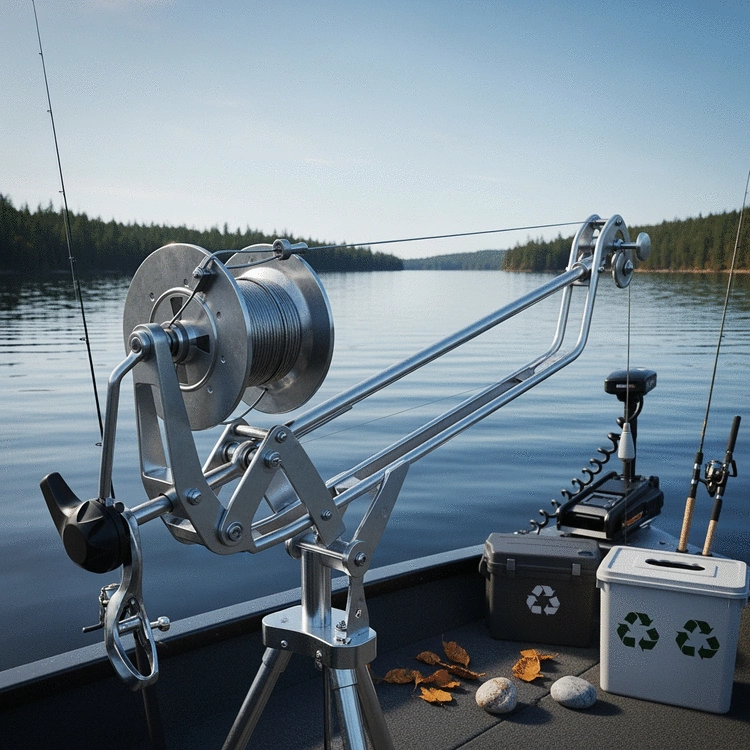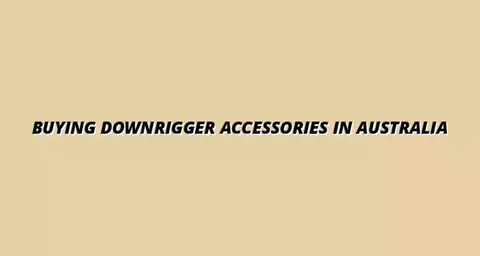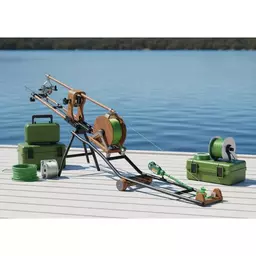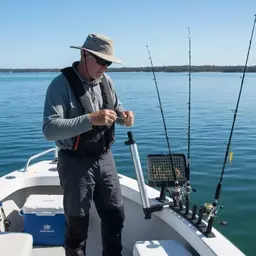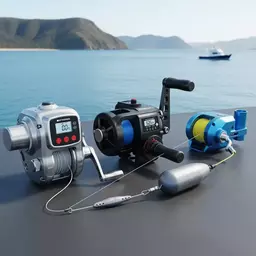Did you know that regular maintenance can significantly enhance the lifespan and performance of your fishing gear? Just like any equipment, downriggers need consistent care to ensure they function at their best. Here’s what you will learn about maintaining your downrigger effectively.
What You Will Learn
- The importance of regular maintenance to prevent unexpected breakdowns and enhance fishing effectiveness.
- Essential tools and supplies needed for effective downrigger care.
- Key parts to inspect during maintenance to ensure optimal performance.
- Best practices for cleaning and lubricating your downrigger components.
- Techniques for maintaining cables to ensure durability and reliability.
- How proper maintenance and recycling contribute to sustainability in fishing practices.
Downrigger Maintenance: A Process Flow for Longevity
This visual outlines the essential steps and components involved in maintaining your downrigger, ensuring its longevity and optimal performance.
Why Maintenance Matters
- Prevents breakdowns
- Enhances effectiveness
- Increases lifespan
- Boosts catch rates
Tools & Supplies
- Soft cloths, Freshwater
- Lubricating oil
- Replacement cables
- Multi-tool/wrench
Key Parts to Inspect
- Boom (corrosion)
- Swivel base (wear)
- Cable (frays/kinks)
- Weights (damage)
Cleaning Guide
- Rinse with freshwater
- Wipe all surfaces
- Inspect swivel base
- Dry completely
Lubrication
- Apply to boom joints
- Oil swivel base
- Lubricate exposed cables
- Wipe excess
Cable Care
- Regular inspection
- Rinse after use
- Check for kinks/frays
- Replace if worn
Benefits
- Enhanced Performance
- Cost Savings
- Environmental Responsibility
- Community Engagement
Community Role
- Education
- Collaboration
- Support local programs
Understanding Downrigger Maintenance for Longevity
Maintaining your downrigger is essential for ensuring its longevity and performance on the water. Just like any piece of fishing equipment, downriggers require regular attention to function at their best. Neglecting maintenance can lead to malfunctions, which not only affects your fishing experience but can also damage your investment. By dedicating time to proper upkeep, you can enhance your downrigger's lifespan and efficiency! For more insights on keeping your gear in top condition, explore our downrigger care tips for anglers.
Why Regular Maintenance Matters for Your Downrigger
Have you ever been on a fishing trip and suddenly found your downrigger isn’t working? It’s frustrating, right? Making maintenance a priority can help avoid those heart-sinking moments. Regular checks ensure that your gear is in top-notch shape, which is vital for both performance and safety when you're out on the water.
- Prevents unexpected breakdowns
- Enhances fishing effectiveness
- Increases the lifespan of your downrigger
- Promotes better catch rates
Ultimately, taking the time to care for your downrigger not only secures your equipment but also boosts your overall fishing success. Remember, a well-maintained downrigger is your best ally when targeting elusive fish!
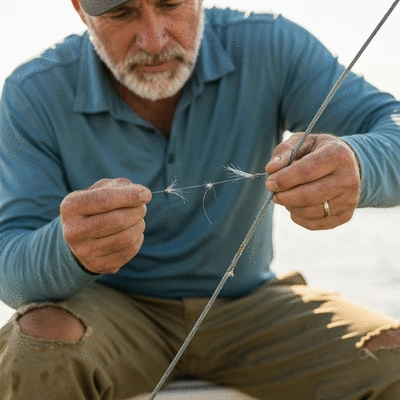
Essential Tools and Supplies for Downrigger Care
When it comes to maintaining your downrigger, having the right tools on hand is half the battle won. Here’s a quick list of essential supplies you'll need:
- Soft cloths for cleaning
- Freshwater for rinsing
- Lubricating oil for moving parts
- Replacement cables
- Multi-tool or wrench set
These tools will help you perform routine checks and essential maintenance tasks. Make sure to keep them organized and accessible so that you can quickly address any issues that arise during your fishing adventures.
Key Downrigger Parts to Inspect During Maintenance
As part of your downrigger maintenance routine, it’s important to focus on key components that require regular inspection. Here are the crucial parts you should check:
- Boom: Ensure it's free from corrosion and functioning smoothly.
- Swivel base: Check for any signs of wear and tear that might affect its movement.
- Cable: Look for frays or kinks that could compromise performance.
- Weights: Inspect for damage or loss that could impact depth control.
By regularly inspecting these components, you can catch potential issues early and keep your downrigger performing at its peak, giving you the best chance for a successful fishing trip!
Key Maintenance Practices for Downriggers
In addition to regular inspections, there are several key maintenance practices that every angler should incorporate into their routine. These practices not only help maintain your downrigger but also improve your overall fishing experience. For comprehensive guidance on both care and troubleshooting, consider our in-depth guide to downrigger care and troubleshooting.
Cleaning Your Downrigger: Step-by-Step Guide
Cleaning your downrigger might seem like a simple task, but it’s vital for preventing corrosion and ensuring it works efficiently. Follow these steps:
- Rinse the downrigger with freshwater after each trip.
- Use a soft cloth to wipe down all surfaces, paying special attention to the boom and cable.
- Inspect the swivel base for any debris or salt buildup.
- Allow the downrigger to dry completely before storing.
By cleaning your downrigger after each use, you’ll help preserve its condition and enhance its functionality for your next fishing adventure!
Cleaning the Boom and Wheel for Optimal Performance
When cleaning the boom and wheel, focus on removing any dirt or salt residue. Use a gentle cleaner to ensure you don't damage the surface. This practice will help maintain smooth operation and prevent wear over time. Regular cleaning of these components is key to keeping your downrigger running like new!
Swivel Base Inspection: What to Look For
During your cleaning, also pay attention to the swivel base. Look for signs of rust or debris that might hinder movement. A functioning swivel base is crucial for the effectiveness of your downrigger, as it allows for smooth adjustments while fishing. If you notice any problems, now is the time to address them!
Lubrication and Moving Parts: Keeping Everything Running Smoothly
Lubrication is another essential aspect of downrigger maintenance. It ensures that all moving parts function smoothly, reducing wear and tear. Here’s how to properly lubricate your downrigger:
- Apply lubricant to the telescoping boom's joints.
- Check the swivel base and add oil if necessary.
- Ensure cables are not twisted and lubricate any exposed sections.
By keeping everything well-lubricated, you can enhance performance and prevent potential issues before they arise!
How to Properly Lubricate the Telescoping Boom
When applying lubricant to the telescoping boom, make sure to use a high-quality marine lubricant. This helps protect against corrosion and ensures smooth operation. Remember to wipe away any excess to prevent buildup.
Maintaining the Swivel Base and Cable Mechanism
Regularly checking the swivel base and cable mechanism is essential for operational efficiency. Look for signs of rust or corrosion and apply lubricant as needed. This simple check can save you from bigger problems down the line!
Cable Care and Maintenance: Ensuring Durability
Cables are a critical part of your downrigger setup, and proper care is essential to ensure their longevity. Here’s how to maintain them effectively:
- Inspect cables regularly for any signs of wear.
- Rinse cables with freshwater after each use to remove salt and debris.
- Check for kinks or frays that could cause failures.
By caring for your cables, you're ensuring that your downrigger operates smoothly and reliably. A healthy cable will enhance your fishing experience by providing the control you need to target those prized catches!
Wire Inspection Techniques to Prevent Corrosion
To prevent corrosion, regularly inspect your wires for signs of wear or salt buildup. A quick rinse with freshwater can go a long way in protecting your cables from the harsh marine environment! If you notice any corrosion, it's best to replace the affected section before it leads to bigger issues.
Replacing Worn Cables: When and How to Do It
If you find that your cables are worn or damaged, it’s crucial to replace them promptly. Here’s a quick guide:
- Determine the correct length and type of cable for your downrigger.
- Remove the old cable and replace it with the new one, ensuring proper attachment.
- Test the new cable for smooth operation before your next trip.
Replacing worn cables not only enhances your downrigger's efficiency but also ensures your safety while fishing!
Choosing Eco-friendly Fishing Line for Downrigger Use
Consider investing in eco-friendly fishing lines that break down naturally in water. These lines not only reduce environmental impact but also enhance your fishing experience. Sustainable choices make a difference in protecting Australia’s marine ecosystems while allowing you to enjoy your passion for fishing! For more details on making environmentally conscious choices, check out our guide on sustainable downrigger fishing practices.
Pro Tip
Did you know? Regularly cleaning and lubricating your downrigger not only prevents corrosion but also enhances its overall performance. A small investment of time in maintenance can significantly improve your fishing success by ensuring smooth operation and reliability on every trip!
Frequently Asked Questions About Downrigger Maintenance
Why is regular downrigger maintenance important?
What tools and supplies are essential for downrigger care?
Which downrigger parts should I inspect regularly?
How should I clean my downrigger after a fishing trip?
How does lubrication contribute to downrigger maintenance?
When should I replace my downrigger cables?
How do maintenance and recycling enhance sustainability in fishing?
Summarizing the Benefits of Proper Downrigger Care and Recycling
Taking care of your downrigger is not just about keeping your gear in top shape; it’s also about enhancing the overall longevity and sustainability of your fishing adventures. Regular maintenance and recycling practices play a crucial role in ensuring that your downrigger performs well for many seasons to come. Just like our beloved Australian marine environments, our gear deserves attention and care!
By engaging in consistent maintenance, you’re ensuring that every component of your downrigger works harmoniously, leading to a smoother fishing experience. Additionally, when it comes to recycling, we're not merely throwing things away; we're making a conscious choice to protect our waters. Here are some key benefits of proper downrigger care and recycling:
- Enhanced Performance: Regular maintenance keeps your gear functioning at peak efficiency.
- Cost Savings: By preventing major repairs through routine care, you can save money in the long run.
- Environmental Responsibility: Recycling reduces waste and conserves natural resources, contributing to marine health.
- Community Engagement: Participating in recycling initiatives fosters a culture of sustainability among fellow anglers.
By actively committing to these practices, we can all contribute to preserving our beautiful Australian waters for future generations of fishers!
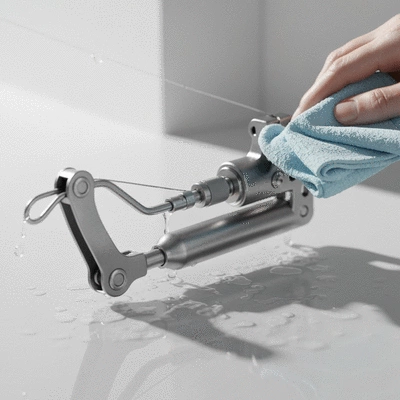
How Maintenance and Recycling Enhance Longevity and Sustainability
When we prioritize downrigger maintenance, we effectively extend the life of our fishing gear. Think about it: a well-cared-for downrigger can accompany you on countless fishing trips, enhancing your experience each time. Pair that with responsible recycling, and you’re not just maintaining your gear—you’re also minimizing your ecological footprint.
Consider these points on how maintenance and recycling work hand-in-hand to promote longevity:
- Preventative Measures: Regular checks can catch potential issues before they escalate, ensuring your gear lasts longer.
- Sustainable Practices: Recycling worn-out parts means less landfill waste and reduces the demand for new materials.
- Community Support: By recycling and maintaining your gear, you inspire others in the fishing community to adopt sustainable practices.
In essence, caring for your downrigger and responsibly disposing of it when it’s time not only benefits you but the entire ecosystem we cherish.
The Role of Fishing Communities in Promoting Environmental Stewardship
As fishers, we share a unique bond with our communities and the waters we fish. Our collective actions can significantly impact the health of our marine ecosystems. Engaging with fellow anglers about sustainable fishing practices amplifies our efforts in environmental stewardship.
Here’s how fishing communities can play a pivotal role:
- Education: Share knowledge about proper maintenance and recycling among peers.
- Collaboration: Work together on local initiatives aimed at cleaning up marine environments.
- Support Local Programs: Get involved with local conservation groups that promote sustainable fishing practices.
By nurturing a sense of responsibility and cooperation within our fishing communities, we can ensure that our waters remain vibrant and flourishing for years to come!
Recap of Key Points
Here is a quick recap of the important points discussed in the article:
- Regular maintenance is crucial for preventing unexpected breakdowns and enhancing the lifespan of your downrigger.
- Essential tools for maintenance include soft cloths, freshwater for rinsing, lubricating oil, and replacement cables.
- Key parts to inspect regularly are the boom, swivel base, cables, and weights to ensure optimal performance.
- Cleaning your downrigger after each use helps prevent corrosion and maintains functionality.
- Lubrication of moving parts is essential to ensure smooth operation and reduce wear and tear.
- Proper cable care, including inspection and rinsing, is vital for durability and performance.
- Engaging in sustainable practices, such as recycling, promotes environmental responsibility within the fishing community.
